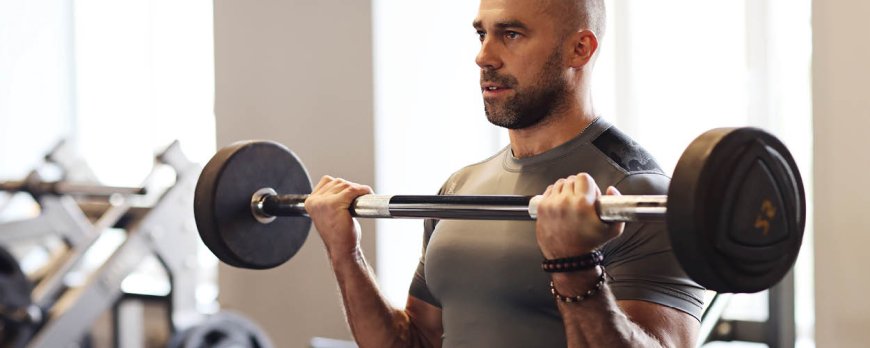How fit is the average American?
Explore 'How fit is the average American?' in our comprehensive guide. Unveil surprising data, fitness trends, and insights for a healthier lifestyle.

How fit is the average American?
The fitness level of the average American and the state of health and fitness in the United States are topics of concern and interest. Data from the Centers for Disease Control (CDC) reveals that only about 23 percent of all U.S. adults meet the recommended amount of exercise per week. The recommended amount is 150 minutes of moderate intensity aerobic exercise, along with two sessions of muscle-strengthening exercise. Various factors such as income, gender, race, ethnicity, marital status, age, and sexual orientation influence exercise levels. Geographically, there is variation in physical activity, with western states generally being more active than southeastern states. In terms of income, individuals in higher brackets are more likely to meet exercise standards compared to those in poverty. Men tend to meet national exercise standards more than women. Overall, about 80 percent of adults do not meet the guidelines for both aerobic and muscle-strengthening activities. However, there has been an increase in physical activity levels during the COVID-19 pandemic, emphasizing the importance of maintaining exercise habits. Regular physical activity offers numerous health benefits, and individuals should strive to overcome obstacles and incorporate exercise into their daily lives.
Key Takeaways:
- Only about 23 percent of U.S. adults meet the recommended amount of exercise per week.
- Factors such as income, gender, race, ethnicity, marital status, age, and sexual orientation influence exercise levels.
- Geographically, western states tend to be more physically active than southeastern states.
- Individuals in higher income brackets are more likely to meet exercise standards compared to those in poverty.
- Men tend to meet national exercise standards more than women.

Physical Activity Guidelines and Statistics
The Centers for Disease Control (CDC) provides guidelines for physical activity, and understanding exercise habits, BMI, and obesity rates in the US can help paint a clearer picture of the average American's fitness level.
According to data from the CDC, only about 23 percent of all U.S. adults get the recommended amount of exercise per week. This recommended amount includes 150 minutes of moderate intensity aerobic exercise, along with two sessions of muscle-strengthening exercise.
Various factors influence exercise levels among Americans, including income, gender, race, ethnicity, marital status, age, and sexual orientation. For example, people in higher income brackets are more likely to meet exercise standards compared to those in poverty. Additionally, men tend to meet national exercise standards more than women.
When examining overall exercise levels in the United States, it is concerning to note that approximately 80 percent of adults do not meet the guidelines for both aerobic and muscle-strengthening activities. However, there is some encouraging news as physical activity levels increased during the COVID-19 pandemic. Nevertheless, it is vital for individuals to continue prioritizing exercise and maintain a regular physical activity routine.
Key Statistics:
- Only 23 percent of U.S. adults meet the recommended exercise guidelines.
- About 80 percent of adults do not meet the guidelines for both aerobic and muscle-strengthening activities.
- People in higher income brackets are more likely to meet exercise standards compared to those in poverty.
- Men tend to meet national exercise standards more than women.
Regular physical activity has numerous health benefits, and it is crucial for individuals to find ways to overcome obstacles and incorporate exercise into their daily lives. By understanding the physical activity guidelines and statistics, we can better support initiatives aimed at improving the fitness level and overall health of the average American.

Factors Influencing Exercise Levels
Exercise levels among Americans are influenced by a range of factors, such as income, gender, race, ethnicity, marital status, age, and sexual orientation. These various factors can significantly impact an individual's likelihood of engaging in regular physical activity.
- Income: Data shows that individuals in higher income brackets are more likely to meet exercise standards compared to those in poverty. Financial stability can provide greater access to fitness facilities, personal trainers, and other resources that facilitate regular exercise.
- Gender: Men tend to meet national exercise standards more than women. This disparity may be due to societal expectations, differences in motivation, or other factors that influence exercise behaviors between genders.
- Race and Ethnicity: Exercise habits can vary among different racial and ethnic groups. Cultural factors, socioeconomic factors, and barriers to fitness resources can all contribute to these differences.
- Marital Status: Married individuals may have different exercise patterns than those who are single or divorced. Relationship dynamics, responsibilities, and shared fitness interests can all influence the likelihood of engaging in physical activity.
- Age: Exercise levels tend to decrease with age, as older adults may face physical limitations or have different priorities. However, staying active is crucial for maintaining health and mobility as individuals age.
- Sexual Orientation: Limited research suggests that exercise habits may vary among individuals of different sexual orientations. Factors such as discrimination, societal pressure, and community support can all play a role.
Understanding these factors is essential for developing targeted interventions and programs that can promote physical activity among all populations. By addressing the barriers and challenges associated with income disparities, gender inequalities, and cultural differences, we can strive to create a more inclusive and active society.
Geographical Variation in Physical Activity
Geographical location plays a role in the physical activity levels of Americans, with notable variations between western states and southeastern states. According to data from the Centers for Disease Control (CDC), western states tend to have higher rates of physical activity compared to southeastern states. This disparity can be attributed to a variety of factors, including differences in climate, culture, and access to recreational facilities.
In western states such as Colorado and California, outdoor activities like hiking, cycling, and skiing are popular due to the favorable weather and abundance of natural landscapes. On the other hand, southeastern states face challenges such as hot and humid climates, which can discourage outdoor physical activity. Additionally, factors such as cultural norms and limited access to parks and recreational spaces may contribute to lower activity levels in these regions.
Factors Influencing Physical Activity
While geographical variation is one factor influencing physical activity levels, it is important to consider other factors as well. Income, for example, plays a significant role in determining exercise patterns. Individuals in higher income brackets generally have greater access to fitness facilities, personal trainers, and other resources that support an active lifestyle.
Gender disparities also exist in exercise levels, with men often meeting national exercise standards more frequently than women. This may be attributed to societal expectations, as well as differences in leisure time activities and perceptions of exercise. Additionally, factors such as age, race, ethnicity, marital status, and sexual orientation can also impact an individual's exercise habits.
Overall, it is evident that geographical location and various socioeconomic factors influence the physical activity levels of Americans. By understanding these variations, we can better address the barriers to physical activity and promote a culture of health and fitness across the country.

Income and Exercise Patterns
The influence of income on exercise patterns highlights the disparities in meeting exercise standards and the challenges faced by those living in poverty. According to data from the Centers for Disease Control (CDC), people in higher income brackets are more likely to meet the recommended amount of exercise per week compared to those living in poverty. This can be attributed to a variety of factors, including access to fitness facilities, resources for exercise equipment or classes, and the ability to prioritize time for physical activity.
Socioeconomic Barriers
Individuals living in poverty often face socioeconomic barriers that hinder their ability to engage in regular exercise. Limited financial resources can make it difficult to afford gym memberships or fitness equipment, which are often necessary to meet exercise standards. Additionally, individuals in poverty may have limited access to safe and accessible outdoor spaces for physical activity, such as parks or trails.
Moreover, the demands of low-income jobs and multiple jobs can leave little time and energy for exercise. The additional stressors and responsibilities associated with living in poverty, such as caring for dependents or dealing with housing instability, can further detract from opportunities for physical activity.
Addressing the Disparities
Efforts must be made to address the disparities in exercise patterns based on income. This includes increasing access to affordable fitness options, providing resources for exercise equipment or classes, and improving access to safe and well-maintained public spaces for physical activity. In addition, targeted programs and initiatives aimed at low-income communities can help educate individuals about the importance of exercise and provide support to overcome barriers.
Healthcare providers and community organizations can play a crucial role in promoting physical activity among individuals living in poverty by offering resources, guidance, and incentives. By addressing the socioeconomic barriers and providing opportunities for exercise, we can work towards reducing the disparities in meeting exercise standards and improving the overall health and well-being of those living in poverty.
Gender Disparities in Exercise
There are noticeable disparities between men and women when it comes to meeting national exercise standards. According to data from the Centers for Disease Control (CDC), only about 23 percent of all U.S. adults get the recommended amount of exercise per week. However, when looking at gender breakdown, men tend to meet these standards more than women.
This difference in exercise levels can be influenced by various factors such as societal expectations, cultural norms, and personal preferences. While both men and women face obstacles to exercise, studies have shown that women often juggle multiple responsibilities, such as work, household duties, and caregiving, which may leave them with less time and energy for physical activity.
It is important to address these gender disparities and encourage more women to prioritize their health and well-being through regular exercise. Women should be empowered to find ways to incorporate physical activity into their daily lives, whether it's through joining fitness classes, participating in team sports, or simply taking brisk walks during breaks.
Key Points:
- About 23 percent of U.S. adults meet the recommended exercise guidelines per week.
- Men tend to meet national exercise standards more than women.
- Factors influencing the gender disparities in exercise include societal expectations and multiple responsibilities women often face.
- Efforts should be made to address these disparities and encourage women to prioritize their health through physical activity.

Overall exercise levels in the US
Surprisingly, the majority of adults in the US do not meet the guidelines for both aerobic and muscle-strengthening activities. According to data from the Centers for Disease Control (CDC), only about 23 percent of all US adults get the recommended amount of exercise per week. The guidelines suggest 150 minutes of moderate intensity aerobic exercise, along with two sessions of muscle-strengthening exercise. However, about 80 percent of adults in the country do not meet these standards.
Factors influencing exercise levels in the US include income, gender, race, ethnicity, marital status, age, and sexual orientation. For example, people in higher income brackets are more likely to meet exercise standards compared to those in poverty. Additionally, men tend to meet national exercise standards more often than women.
Geographical variation also plays a role in exercise levels, with western states generally being more physically active than southeastern states. Despite these disparities, encouragingly, physical activity levels increased during the COVID-19 pandemic. However, it is important for individuals to continue exercising to maintain these positive trends.
Regular physical activity has numerous health benefits, including improved cardiovascular health, reduced risk of chronic diseases, and better mental well-being. It is crucial for individuals to find ways to overcome obstacles and incorporate exercise into their daily lives. By prioritizing physical activity and making it a part of their routines, individuals can experience the positive impact of exercise on their overall health and well-being.
Increase in Physical Activity During the Pandemic
The COVID-19 pandemic led to an increase in physical activity levels, as people sought ways to stay active and maintain their health while adhering to lockdown measures. With gyms closed and limited outdoor activities available, individuals turned to home workouts, virtual fitness classes, and outdoor exercises like walking, jogging, and cycling to stay physically active.
This surge in physical activity during the pandemic was a positive trend, as regular exercise has numerous health benefits. It helps improve cardiovascular health, strengthen muscles and bones, boost mood, reduce stress, and maintain a healthy weight. Additionally, staying active during this challenging time provided a sense of routine and purpose, helping to alleviate feelings of isolation and anxiety.
However, as we navigate the post-pandemic world, it is crucial to sustain these habits and continue prioritizing physical activity. With the reopening of gyms and the resumption of regular activities, there may be a temptation to revert to sedentary lifestyles. To avoid this, individuals should aim to maintain the exercise routines they developed during the pandemic by incorporating physical activity into their daily lives.
Whether it's scheduling regular workouts, participating in community sports, or simply being more active throughout the day, finding enjoyable and sustainable ways to stay physically active is essential for long-term health and well-being. By making exercise a priority, we can reap the benefits of improved physical fitness, increased energy levels, and better overall health.
Ways to Sustain Physical Activity Habits:
- Create a weekly exercise schedule to ensure regularity and consistency.
- Join a local sports club or fitness group to stay motivated and engaged.
- Set realistic goals and track progress to maintain a sense of accomplishment.
- Find enjoyable activities that make exercise feel like a fun and rewarding part of your daily routine.
- Bring a friend or family member along to make exercise a social and enjoyable experience.
- Take advantage of outdoor spaces and explore new trails or parks for a change of scenery.
- Utilize technology by using fitness apps or wearable devices to track your activity levels and progress.
The benefits of regular physical activity
Regular physical activity offers a myriad of health benefits, making it essential to prioritize exercise in our daily lives. Not only does exercise help to maintain a healthy weight and improve cardiovascular health, but it also plays a crucial role in reducing the risk of chronic diseases, such as heart disease, diabetes, and certain types of cancer.
Engaging in regular physical activity can also have a positive impact on mental health and well-being. Exercise has been shown to reduce symptoms of anxiety and depression, improve mood, and enhance cognitive function. Additionally, it can promote better sleep and increase overall energy levels, leading to improved productivity and quality of life.
Here are some of the key health benefits of regular physical activity:
- Weight management: Exercise helps to burn calories and build lean muscle, contributing to weight loss and weight maintenance.
- Stronger bones and muscles: Physical activity stimulates bone and muscle growth, which is important for maintaining healthy bones and preventing age-related muscle loss.
- Improved heart health: Regular aerobic exercise strengthens the heart and improves circulation, reducing the risk of cardiovascular diseases.
- Enhanced mental well-being: Exercise releases endorphins, the body's natural feel-good chemicals, promoting a positive mood and reducing stress.
- Reduced risk of chronic diseases: Regular physical activity lowers the risk of developing chronic conditions, including type 2 diabetes, certain cancers, and high blood pressure.
- Increased longevity: Studies have shown that individuals who engage in regular exercise tend to live longer and have a higher quality of life as they age.
To reap these health benefits, it's important to find physical activities that you enjoy and can incorporate into your daily routine. Whether it's going for a brisk walk, cycling, swimming, or practicing yoga, any form of movement can make a positive impact on your overall health and well-being. Start small and gradually increase the duration and intensity of your workouts to build a sustainable exercise habit. Remember, every little bit of physical activity counts, and the long-term benefits are well worth the effort.
Overcoming Obstacles to Exercise
Overcoming obstacles is crucial in maintaining a consistent exercise routine and integrating physical activity into our daily lives. While it can be challenging at times, addressing these barriers is essential for improving our overall health and well-being. Here are some common obstacles people face when it comes to exercise, along with practical tips for overcoming them:
- Lack of time: Many individuals struggle to find time for exercise amidst their busy schedules. To overcome this obstacle, it can be helpful to prioritize physical activity by scheduling it into your daily routine. Consider waking up a bit earlier or utilizing your lunch break for a quick workout. Additionally, breaking exercise into shorter, more frequent sessions throughout the day can be just as effective as one longer session.
- Lack of motivation: Staying motivated can be a challenge, especially when faced with fatigue or other competing priorities. To combat this, find activities you enjoy and make them a part of your routine. Whether it's dancing, swimming, or hiking, engaging in activities that bring you pleasure can make exercising more enjoyable and easier to stick with. Additionally, setting specific goals and tracking your progress can help maintain motivation and provide a sense of accomplishment.
- Financial constraints: Financial limitations can sometimes hinder access to gym memberships or equipment. However, exercise doesn't have to cost a fortune. There are plenty of low-cost or free options available, such as walking, jogging, or following exercise routines on YouTube or fitness apps. Additionally, many communities offer free or discounted fitness classes and programs, so be sure to explore local resources.
By addressing these obstacles head-on and implementing strategies to overcome them, we can make exercise a regular part of our lives. Remember, even small changes can have a big impact on our overall health and well-being. Start by identifying the specific challenges you face, and then develop a plan to overcome them. With perseverance and determination, you can conquer these barriers and make physical activity a consistent and enjoyable part of your daily routine.

Emerging Wellness Trends in America
The wellness landscape in America is continuously evolving, with emerging trends reshaping the way individuals approach fitness and health. As people become more proactive in taking care of their well-being, new concepts and practices are gaining popularity across the country. Here are some of the emerging wellness trends in America:
- Mindfulness and Meditation: With the increasing awareness of mental health, Americans are embracing mindfulness and meditation practices. These techniques help individuals reduce stress, improve focus, and promote overall well-being. Mindfulness apps and guided meditation programs have become go-to resources for those seeking inner peace.
- Functional Fitness: In contrast to traditional gym workouts, functional fitness focuses on movements that mimic real-life activities. This trend emphasizes strength, mobility, and flexibility to enhance daily life functions and prevent injuries. Functional fitness programs, such as HIIT workouts and CrossFit, have gained a dedicated following across the nation.
- Plant-Based Diets: More Americans are adopting plant-based diets, driven by health and environmental concerns. Plant-based eating emphasizes whole foods and limits or eliminates animal products. This trend has led to an increase in plant-based alternatives to meat and dairy products, as well as a growing number of vegetarian and vegan restaurants.
Customize Your Wellness Journey
As the wellness landscape expands, customization has become a key aspect of individual wellness journeys. People are recognizing that each person's needs and preferences are unique, and are seeking tailored approaches to their well-being. This includes personalized workout plans, DNA testing for nutrition and fitness optimization, and wellness retreats that cater to specific interests, such as yoga or meditation.
With these emerging trends and the growing emphasis on holistic well-being, individuals are encouraged to explore and adapt practices that resonate with them. By integrating these trends into their lives, Americans are taking proactive steps towards a healthier and more fulfilling lifestyle.
Conclusion
Understanding the fitness level of the average American and the state of health and fitness in the United States is crucial for promoting a healthier nation. According to data from the Centers for Disease Control (CDC), only about 23 percent of all U.S. adults get the recommended amount of exercise per week.
The recommended amount is 150 minutes of moderate intensity aerobic exercise, along with two sessions of muscle-strengthening exercise. However, various factors affect exercise levels, including income, gender, race, ethnicity, marital status, age, and sexual orientation.
Geographical variation also plays a role, with western states generally being more physically active than southeastern states. Income is another significant factor, as those in higher income brackets are more likely to meet exercise standards compared to those living in poverty. Men tend to meet national exercise standards more than women.
Overall, about 80 percent of adults in the United States do not meet the guidelines for both aerobic and muscle-strengthening activities. Despite this, there has been an encouraging increase in physical activity levels during the COVID-19 pandemic. It is important, however, to continue exercising and maintaining a regular physical activity routine.
Regular physical activity has numerous health benefits, including reducing the risk of chronic diseases, improving mental well-being, and enhancing overall quality of life. Overcoming obstacles to exercise, such as lack of time or motivation, is essential for individuals to incorporate physical activity into their daily lives.
By staying informed about the fitness level of Americans and the state of health and fitness in the U.S., individuals and communities can work together to create a culture of wellness and promote healthier lifestyles for all.
FAQ
How many U.S. adults get the recommended amount of exercise per week?
Only about 23 percent of all U.S. adults get the recommended amount of exercise per week.
What is the recommended amount of exercise per week?
The recommended amount is 150 minutes of moderate intensity aerobic exercise, along with two sessions of muscle-strengthening exercise.
What factors influence exercise levels?
Factors influencing exercise levels include income, gender, race, ethnicity, marital status, age, and sexual orientation.
How does physical activity vary geographically in the United States?
Physical activity levels vary geographically, with western states generally being more physically active than southeastern states.
How do income levels affect exercise patterns?
People in higher income brackets are more likely to meet exercise standards compared to those in poverty.
Do men or women tend to meet national exercise standards more?
Men tend to meet national exercise standards more than women.
What percentage of adults do not meet exercise guidelines for both aerobic and muscle-strengthening activities?
Overall, about 80 percent of adults do not meet the guidelines for both aerobic and muscle-strengthening activities.
Did physical activity levels increase during the COVID-19 pandemic?
Encouragingly, physical activity levels increased during the COVID-19 pandemic, but it's important to continue exercising.
What are the benefits of regular physical activity?
Regular physical activity has numerous health benefits, including improved cardiovascular health, weight management, and reduced risk of chronic diseases.
How can individuals overcome obstacles to exercise?
Individuals can overcome obstacles to exercise by finding activities they enjoy, setting realistic goals, and incorporating physical activity into their daily routines.
What are some emerging wellness trends in America?
Some emerging wellness trends in America include virtual fitness classes, wearable fitness technology, and functional fitness training.


































































































































